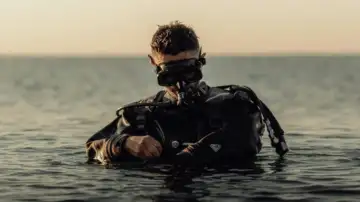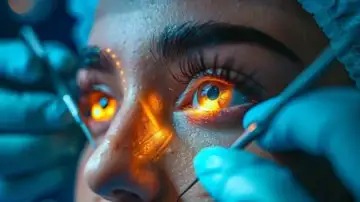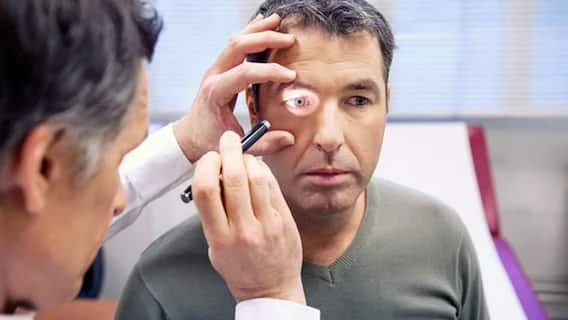You body is performs miracles you’re not even aware of. Beneath the surface of your conscious actions lie a network of powerful, involuntary reflexes.
These quick responses are hardwired by evolution to protect and stabilise you. While the knee-jerk reflex or the blinking response might be familiar, there are other surprising human reflexes that you use everyday without even realising. These hidden mechanisms reveal just how complex and fascinating the human body truly is. Here are six such reflexes that might just blow your mind and make you marvel at what your body can do automatically.
1. The Diver’s Reflex
 (Image Source: Canva)The Mammalian Diving Reflex activates the second your face touches cold water. Instantly, your heart rate slows down, blood flow is redirected to vital organs and oxygen consumption drops. This reflex is found in all mammals. It’s evolved to protect us from drowning. It’s most prominent in children, which is why young kids have survived longer underwater than adults in freezing conditions. Free divers often train to enhance this reflex and use it to hold their breath for several minutes. It’s a survival tool that shows us how our body prioritises brain and heart functions in emergencies.
(Image Source: Canva)The Mammalian Diving Reflex activates the second your face touches cold water. Instantly, your heart rate slows down, blood flow is redirected to vital organs and oxygen consumption drops. This reflex is found in all mammals. It’s evolved to protect us from drowning. It’s most prominent in children, which is why young kids have survived longer underwater than adults in freezing conditions. Free divers often train to enhance this reflex and use it to hold their breath for several minutes. It’s a survival tool that shows us how our body prioritises brain and heart functions in emergencies.
2. Pupillary Light Reflex
 (Image Source: Pinterest/freepik)When you walk from a dark room into bright sunlight, your pupils shrink instantly. This pupillary light reflex isn’t just about adjusting to brightness. It’s a neurological test used by doctors to assess brain function. But here’s the twist: even if you shine a light in one eye, both pupils contract, this is due to a shared neural pathway. There are some studies that show this reflex can persist in people who are in a coma. This helps doctors assess the integrity of the midbrain. It’s your brain’s built-in mechanism for protecting the retina from excessive light and balancing visual clarity.
(Image Source: Pinterest/freepik)When you walk from a dark room into bright sunlight, your pupils shrink instantly. This pupillary light reflex isn’t just about adjusting to brightness. It’s a neurological test used by doctors to assess brain function. But here’s the twist: even if you shine a light in one eye, both pupils contract, this is due to a shared neural pathway. There are some studies that show this reflex can persist in people who are in a coma. This helps doctors assess the integrity of the midbrain. It’s your brain’s built-in mechanism for protecting the retina from excessive light and balancing visual clarity.
3. Tonic Neck Reflex
 (Image Source: Pinterest/whattoexpect)Tonic Neck Reflex is also called the “fencing reflex.” It’s common in babies when they turn their head to one side and extend the arm on the same side. This reflex helps them prepare for coordinated movements and even crawling. What’s fascinating is that its presence and disappearance at the right developmental stage can be an early indicator of neurological health. If it persists beyond 5-6 months, it could hint at underlying developmental issues. This reflex is your body’s early training ground for muscle coordination and spatial orientation.
(Image Source: Pinterest/whattoexpect)Tonic Neck Reflex is also called the “fencing reflex.” It’s common in babies when they turn their head to one side and extend the arm on the same side. This reflex helps them prepare for coordinated movements and even crawling. What’s fascinating is that its presence and disappearance at the right developmental stage can be an early indicator of neurological health. If it persists beyond 5-6 months, it could hint at underlying developmental issues. This reflex is your body’s early training ground for muscle coordination and spatial orientation.
4. The Startle Reflex
 (Image Source: Pinterest/destinycolston)Also known as the Moro reflex in infants, this reflex is the body’s instant reaction to sudden loud noises or unexpected movement. . It manifests as a full-body jerk, often with raised arms, ready to guard or flee. In prehistoric times, this reflex helped humans and animals detect predators or threats before they became fatal. This reflex lingers in adults as that jolt that you feel when startled awake or hearing a sudden bang. The Startle Reflex is also closely linked to your fight-or-flight response and is exaggerated in those with PTSD or high anxiety.
(Image Source: Pinterest/destinycolston)Also known as the Moro reflex in infants, this reflex is the body’s instant reaction to sudden loud noises or unexpected movement. . It manifests as a full-body jerk, often with raised arms, ready to guard or flee. In prehistoric times, this reflex helped humans and animals detect predators or threats before they became fatal. This reflex lingers in adults as that jolt that you feel when startled awake or hearing a sudden bang. The Startle Reflex is also closely linked to your fight-or-flight response and is exaggerated in those with PTSD or high anxiety.
5. Vestibulo-Ocular Reflex
 (Image Source: Pinterest/midinahesenli)Try shaking your head side to side while keeping your eyes fixed on a word. Notice how your vision stays stable? That’s the Vestibulo-Ocular Reflex in action. It helps in coordinating your inner ear and eye muscles to stabilise vision when your head moves. Without this reflex, you would feel blurry every time your nodded or turned your head. This reflex id extremely fast and can react in milliseconds. It’s crucial for balance, coordination, and reading while walking or riding in a vehicle. Pilots and athletes rely on a well-trained VOR to stay oriented during rapid motion.
(Image Source: Pinterest/midinahesenli)Try shaking your head side to side while keeping your eyes fixed on a word. Notice how your vision stays stable? That’s the Vestibulo-Ocular Reflex in action. It helps in coordinating your inner ear and eye muscles to stabilise vision when your head moves. Without this reflex, you would feel blurry every time your nodded or turned your head. This reflex id extremely fast and can react in milliseconds. It’s crucial for balance, coordination, and reading while walking or riding in a vehicle. Pilots and athletes rely on a well-trained VOR to stay oriented during rapid motion.
6. Withdrawal Reflex
 (Image Source: Canva)When you touch something hot, your hand pulls away before even realising what happened. That’s the withdrawal reflex. It bypasses the brain, routing signals straight from sensory nerves to the spinal cord and back to your muscles. It’s one of the fastest reflexes in your body, designed for injury prevention. What’s even more interesting is that this reflex can trigger a crossed-extension response, meaning if one leg withdraws from pain, the other stiffens to support balance. It’s a perfectly timed survival system that reacts without permission, proving your body prioritises protection before logic.
(Image Source: Canva)When you touch something hot, your hand pulls away before even realising what happened. That’s the withdrawal reflex. It bypasses the brain, routing signals straight from sensory nerves to the spinal cord and back to your muscles. It’s one of the fastest reflexes in your body, designed for injury prevention. What’s even more interesting is that this reflex can trigger a crossed-extension response, meaning if one leg withdraws from pain, the other stiffens to support balance. It’s a perfectly timed survival system that reacts without permission, proving your body prioritises protection before logic.
